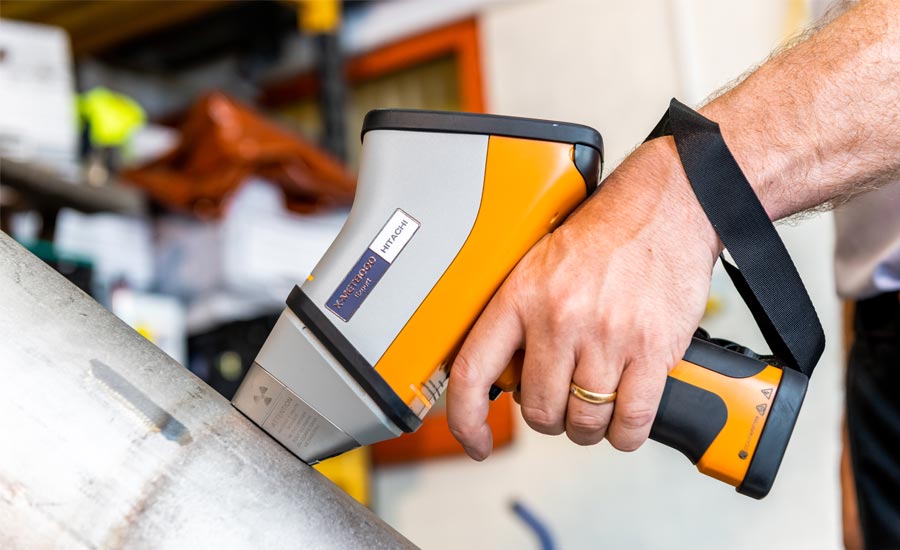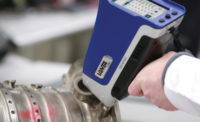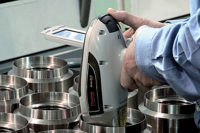Handheld X-Ray Fluorescence (HHXRF) analyzers verify materials quickly, reliably and cost-efficiently. They can identify a material’s elemental makeup within seconds, making it easier for manufacturers to select the right metal grades and tolerances for their needs. Such precision is essential for reliable part performance, especially in aerospace, oil and gas and pharmaceutical industries.
XRF can show the user a sample’s raw material composition, which is critical, says Michel Zoontjes, product manager, Malvern Panalytical B.V.
“The ratio between elements such as calcium, iron and silicon determine the final strength of a building, and in pharmaceutical drugs, it is crucial to make sure there are no toxic elements present that could harm the patient,” he says.
Ted Shields, director of ANI Products, Olympus, agrees.
“Many metal parts look the same to the naked eye,” says Shields. “However, different metal grades can have different tolerances to withstand various stresses, strains and environmental conditions. Using the wrong grade in the wrong application can cause problems.”
XRF also happens to be the only completely nondestructive materials analysis technology on the market. It won’t mark the sample’s surface, making it appropriate for not just raw materials but also for checking outgoing materials and finished parts.
In the past, wet chemistry or inductive plasma coupling were the best way to check for elemental impurities, says Zoontjes.
“They’re accurate, but time consuming and costly. XRF is simpler to deploy and gives you results in minutes, not hours,” he said. “XRF operators don’t need a chemistry background to get a trusted reading and because of this, XRF is very suitable for process control.”
Handheld XRF instruments are “very tool-like” and are easy to operate, says Christoffer Beck, product business development manager, Hitachi.
“At their simplest, HHXRF can just be pointed at the part being measured and after pulling the trigger, results will show up on an easy-to-read screen in matter of seconds,” Beck explains.
They are also portable and users can easily connect them to mobile apps and cloud services.
“This way the results can be shared instantly, data is safe, and photographs of the measured parts and materials can be stored together with the results,” Beck says.
Although XRF analyzers can be used for years with minimal maintenance, manufacturers should re-certify their XRD instruments annually, experts say.

Handheld XRF instruments are “very tool-like” and are easy to operate. Source: Hitachi
How XRF helps advance quality
Handheld XRF analyzers are most commonly used to inspect and guarantee the correct material composition of incoming parts. “History has shown many cases where a supplier could provide companies with wrong material by accident or even intentionally,” says Beck. “Material certificates can also get lost or get mixed-up. Therefore, checking incoming goods is becoming more common.” XRF is also quite versatile. Scrap metal dealers, manufacturers, exploration geologists, The Restriction of Hazardous Substances Directive compliance officers, and oil and gas positive material identification-specialists have long known the value of XRF, Shields says. “What all these applications have in common is the need to identify materials, confirm that certain components are made of the proper alloy, or verify that a harmful element, like lead or mercury, isn’t present,” he says. “Without an analytical technique like XRF, you are flying blind and trusting the supplier’s documentation.”
Trends in XRF technology
Connectivity, digitization and data are big XRF buzzwords. “Like all industries around us, data is getting increasingly important,” says Beck. This applies to capturing the results as well as providing customers with advanced data analysis and management solutions. This requires getting XRF devices on-line, he says. Some organizations are even building their XRF tools to be installed and integrated for automated testing. In-line or automated XRF eliminates the mistakes caused by inspector fatigue or human error, Shields says, which is much better than manual inspection. XRF inspection used to happen when a part was installed but today, customers are pushing this requirement up the supply chain, he says. “A manufacturer with 100% inspection and analysis of outgoing material has a competitive advantage. I am convinced that the value of knowing the composition of your material will become more and more obvious to people near the material source in the manufacturing sector,” he says. “On the instrument side, the natural evolution toward more reliable, rugged and capable analyzers is expanding the reach of handheld XRF. While some markets are very familiar with what XRF can do, others are just now starting to realize the value of portable elemental analysis. Even after more than 13 years in the industry, I am continually impressed by the capability and utility of these compact devices.” HHXRF is becoming a mature technology and the differences in technical specifications are getting smaller, says Beck. For example, basic tasks such as sorting steel can now be done reliably with any instrument. “The differences are in niche applications which require many years of experience in the industry and knowledge of the developing customer requirements,” he says. These could include new alloying elements and new regulations to screen contaminants, among others, he adds.
Challenges of using XRF
But XRF—both handheld and benchtop—isn’t perfect, experts say. Some users worry about X-ray emission, but, Shields says, handheld XRF uses low-power X-rays. “The safety rules are simple. Don’t point the instrument at anyone and pull the trigger—keep the analyzer on the sample while testing,” he says. Beck calls the X-rays XRF’s “biggest challenge by far,” but says they are perfectly safe to use when operated according to manufacturer’s instructions. Radiation licenses, however, can be costly in some countries. HHXRF analyzers just take some getting used to, Shields says. “Some users are intimidated that they have a scientific instrument in their hand,” he says. “A little experience helps to get the instrument set up the way you want it, but after that, it is just point and shoot and the screen tells you the results.” While XRF has been the most widely adopted technique for handheld metal analysis, it left analytical and usability gaps, says David Mercuro, vice president, marketing, Rigaku Analytical Devices. Mercuro says the latest trend in handheld metal analysis technology is laser induced breakdown spectroscopy (LIBS). “Better suited for measuring light alloying elements, such as Be, Al, Mg, Si, and Li, the utilization of a laser means there are no radiation concerns, making it safer to use while also eliminating added licensing and registration fees,” he says. While HHXRF promises speed, flexibility and portability, choosing the right sample representation can also be a challenge, and that goes for any handheld metal analysis technology, Zoontjes says. “If you want to trust the numbers, a benchtop and some sample preparation is typically well worth the effort,” he says. “For example, by milling and homogenizing the sample to a fine powder and loading it into the sample cup, you are already improving the accuracy. Many customers will go even further and will fuse their sample to a bead to be sure that only the elemental ratio is measured and nothing else.”
.jpg?1621530074)


